Hotone Ampero Library Manager

Table of content
- What is it?
- Download
- Warning
- User manual
- Need help or found a bug?
- Support further development and bug fixes
- Privacy Policy
Organize your Ampero Patches like a library
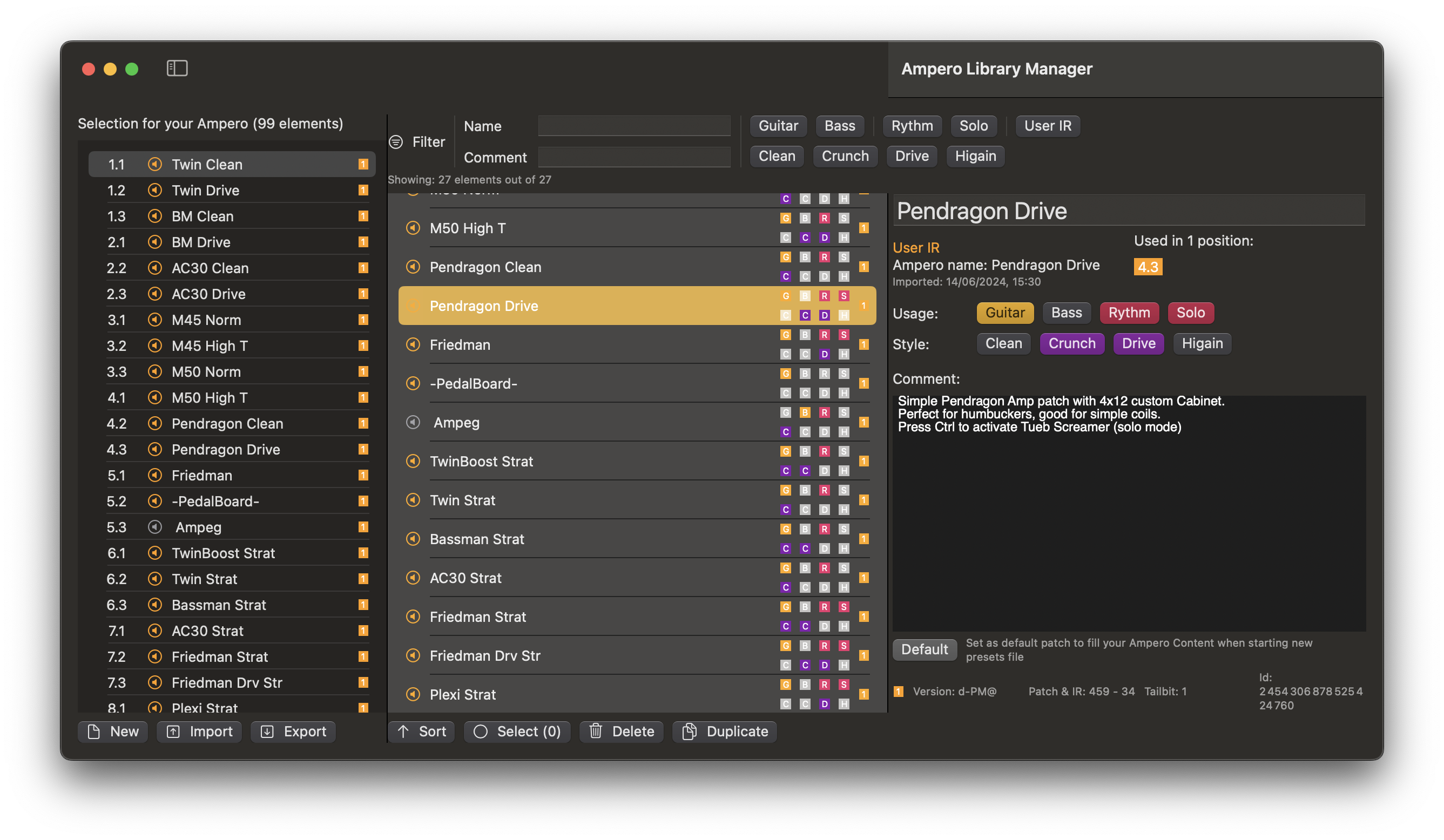
A patches library manager and organizer for Hotone Ampero (Ampero, Ampero One, Ampero Mini).
What is it?
An Ampero Library Manager, a companion app of the Hotone Ampero Editor, to manage the patches of your Ampero.

Available for MacOS, version 14.5 or more.
Download
Current version is “beta 0.9 (7)”.
See download folder to get older versions
Support development effort! Donate via PayPal.
Warning
This software is not a Hotone Product, and has been created only by retro-engineering the Ampero preset files.
By using this software, you know that the generated .prst files have not been created by a genuine Hotone product and you assume taking the risk of using them.
If you disagree, don’t use the software.
User manual
What is a library?
The library is a collection of your own Ampero patches, contained as standard Ampero preset files of 1 patch, in a folder of the computer, and managed by the software described here.
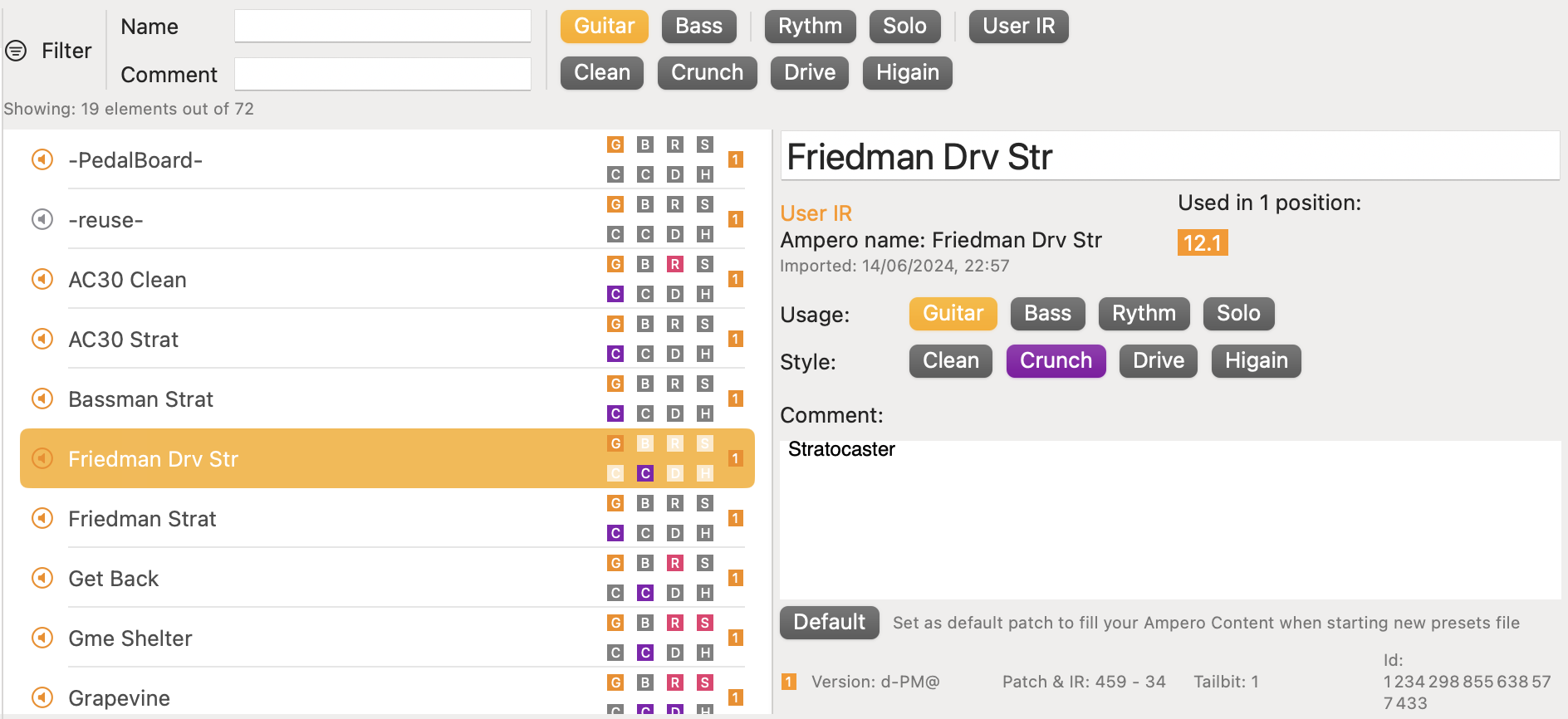
Because patch files are opaque, they need descriptions: is this patch containing a userIR, is it for guitar or bass, is it for a solo, is it for Rolling Stones, for Pink Floyd or for both, was it for a specific gig, for a specific guitar type, etc.?
Also patch files are not understandable: are these two patches with the same name different? is this patch used in a specific (99) presets file?
The Library Manager allows the user to add descriptions and to differentiate different patches with same name, or same patches with different names.
Just like books in a library, these informations are not stored in the patch files but in a catalog. Just like your photo library, the patches library is a copy of patches you decide to save in it. Stupid loss of disk space? Maybe, but a 6Mb photo file has the size of 10000 patch files!
Because you now have a catalog, you can filter, sort, select, remove, append and duplicate patches. And because it stores the original patch files you can create a 99 patches file for the Ampero on the go (starting from nothing), or customize an existing one.
Since they are standard files, you can also access the library folder and use the single patch files freely, they remain Ampero compatible without using the Ampero Library Manager software.
In a nutshell: the workflow
0- Export your Ampero patches using the Hotone Ampero Editor. My software, Ampero Library Manager, can only handle .prst files, it does not communicate with the Ampero.
1- When launching the Library Manager for the first time, the library is empty. Open a 99 (or 1) patches preset file, it displays its content on the left panel of the application’s window. Then simply drag and drop patches from the content panel (left) to the library panel (middle).
2- Since then, the library begins to be populated. You can rename the patches, add the descriptions as described above, and sort, filter, remove patches, …
3- Do this with a lot of patches you like, and - as a library manager, take care of your descriptions and the quality of your catalog!
4- Then comes the next gig, you have a set of 35 patches to put in your Ampero. Open the software, and if not already done, chose a patch in your library that will be used as the default patch to fill a new 99 patches file. An advice for this default patch: chose a clean patch or even a patch with all effects turned off, duplicate it, rename it “empty”, and define it as the default patch. Then create your Ampero file, it will look like a collection of 99 empty slots.
5- Select the 35 patches you need for the gig from the library, with the help of the names and descriptions, drag and drop them in the 99 “empty” file, and here you are. You can drag 1 at a time, or 5, or 35… whatever! using the multi-selection tool.
6- Eventually, change the order of the patches inside the left panel, because you KNOW that doing this with the Hotone Ampero Editor software is not easy.
7- Export your new 99 presets file and import it in the Ampero using the Hotone Ampero Editor software.
You are now ready for the next gig!
Start screen
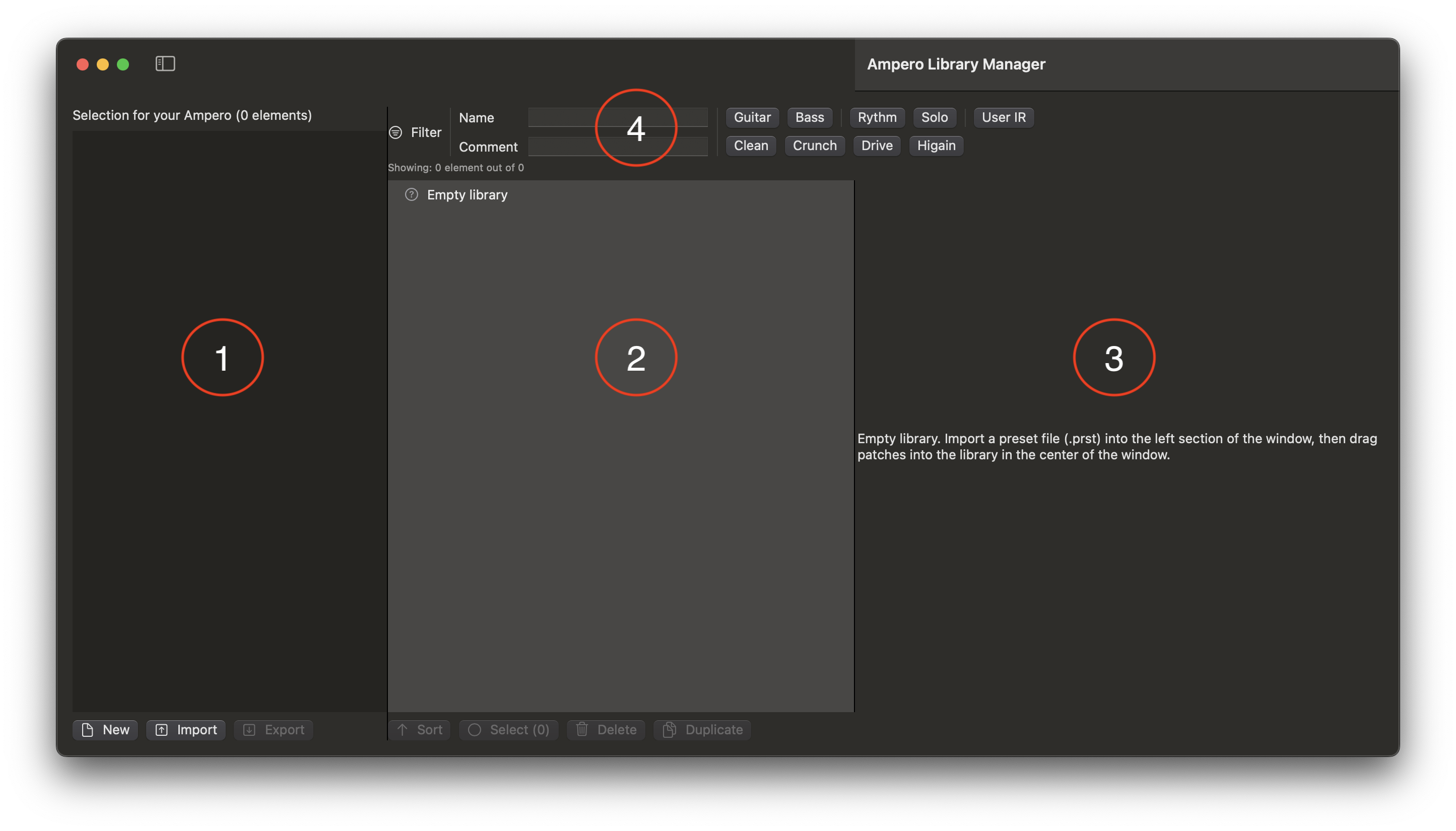 When launching the app for the first time, everything is desperately empty.
When launching the app for the first time, everything is desperately empty.
- The left panel (number 1 above) will display the patches from an Ampero preset file (.prst) that you will import, or create and modify.
- The center panel (number 2 above) is the library, it will display the patches you’ll want to save and describe in your library.
- The right panel (number 3 above) will display the details about the selected patch in the library. This is also the place where you decribe the patch the way you want.
- The upper panel (number 4 above) is the search and filter engine. It only affects the displaying of the patches of the library panel (2).
Importing an Ampero preset file
The first thing you’ll have to do is to import an Ampero .prst file. This is done by clicking the “Import” button in the left panel, or in the menu.
Select a file that you previously export with the Hotone Ampero Editor, and its content will be shown in the left panel.
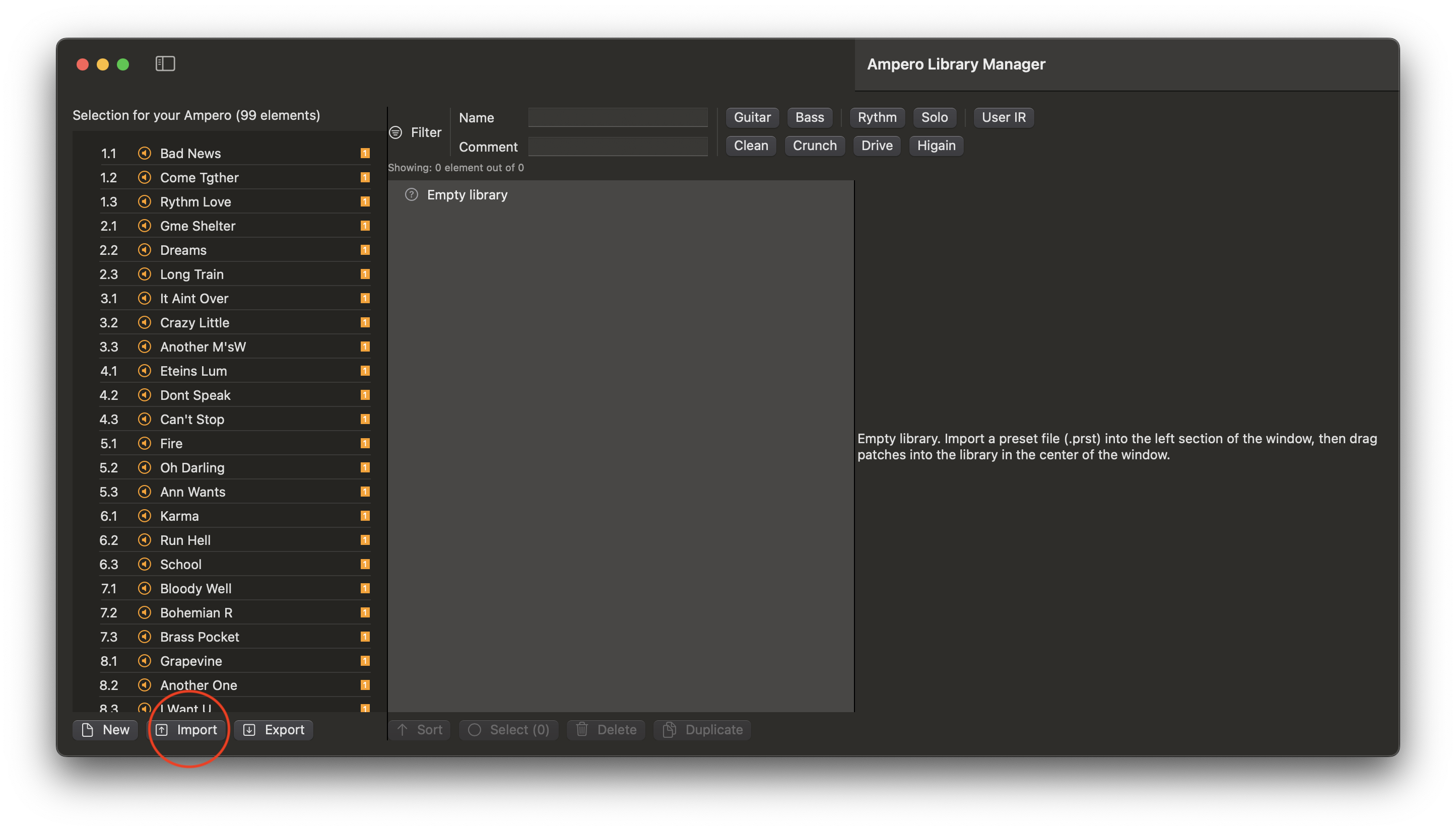
Adding patches in the library
Next thing you have to do: select the patches from the left panel to drag and drop them into the library (center panel). Simply select one, 5 or all patches, and drop them in the library panel.
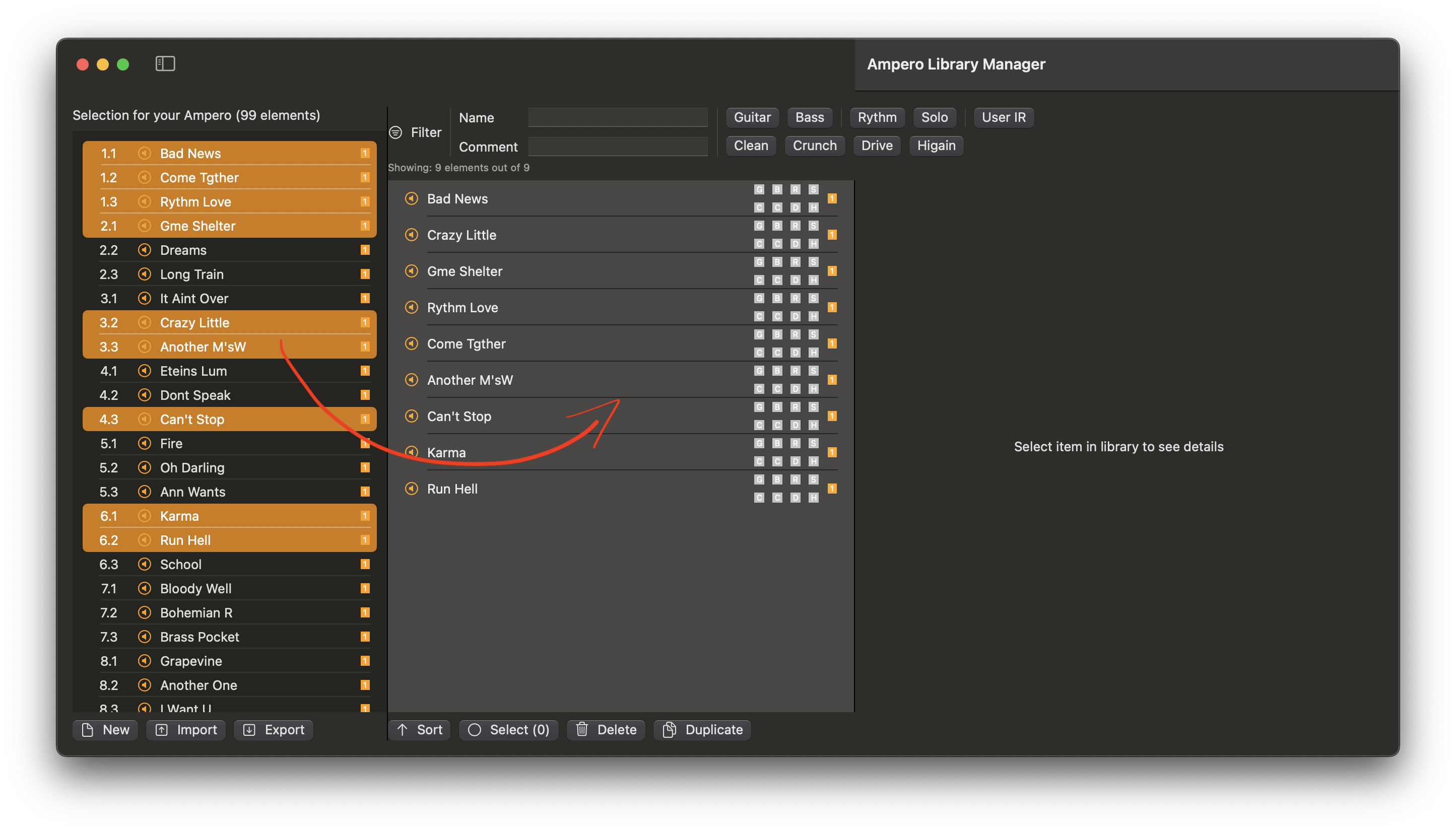
Adding descriptions to the library patches
Once this is done, you can use the advanced features of the library: select on patch from the library panel, the right panel will then show details about the patch.
There are several details you can see and some you can edit in this panel:
- Name: you can rename the patch here, and even give a name longer than the 16 characters of the Ampero (but only the first 16 will be used by Ampero). Watch carefully: changing the name in the library also changes the name of ALL the same patches in the left panel (but don’t worry, the original file is not affected, you will have to export it).
- User IR or Stock IR information: cannot be modified.
- Used in Ampero file: this field informs you where the current selected patch is used in the Ampero preset file displayed in the left panel. The term “used in” means that the parameters of the patch are the same between library and the preset file. The names can be different.
- Usage and Style: you can use these informations to characterise precisely your patch, according to the usage of it: for guitar or bass, for rythm and/or solo, with a clean, crunch, drive or high gain sound.
- Comment: type any description you want here: band name, guitar you’ll using with this patch, gig date, …
- Default: as said above, you can define this patch as the default one, for the time you’ll decide to create a new Ampero preset file, starting from (quite) nothing.
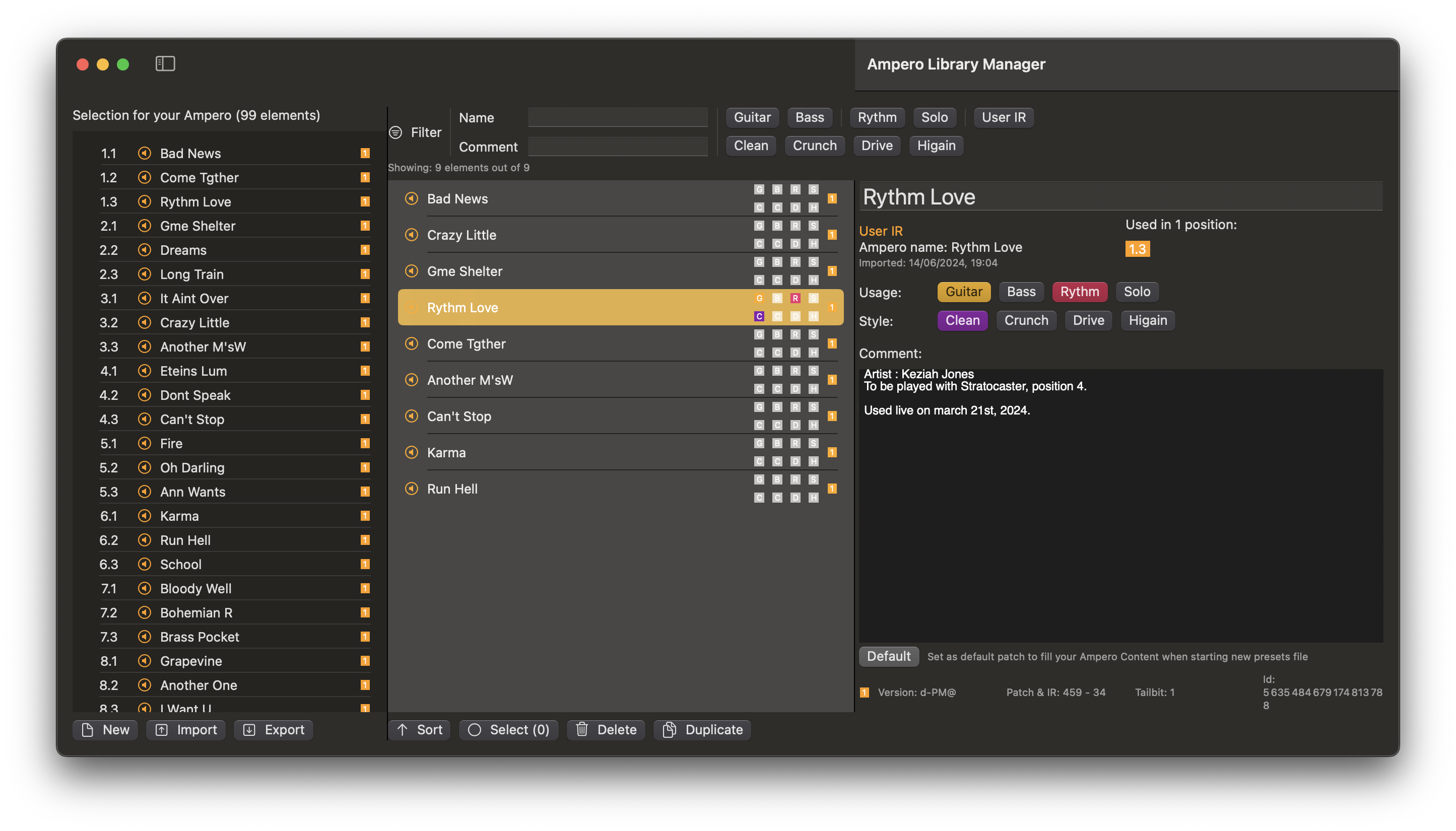
Filter and search
Use the upper panel to search and filter the content of your library. It will use the informations described above. In the following example, searching “keziah” in the comment field returned the right patch.
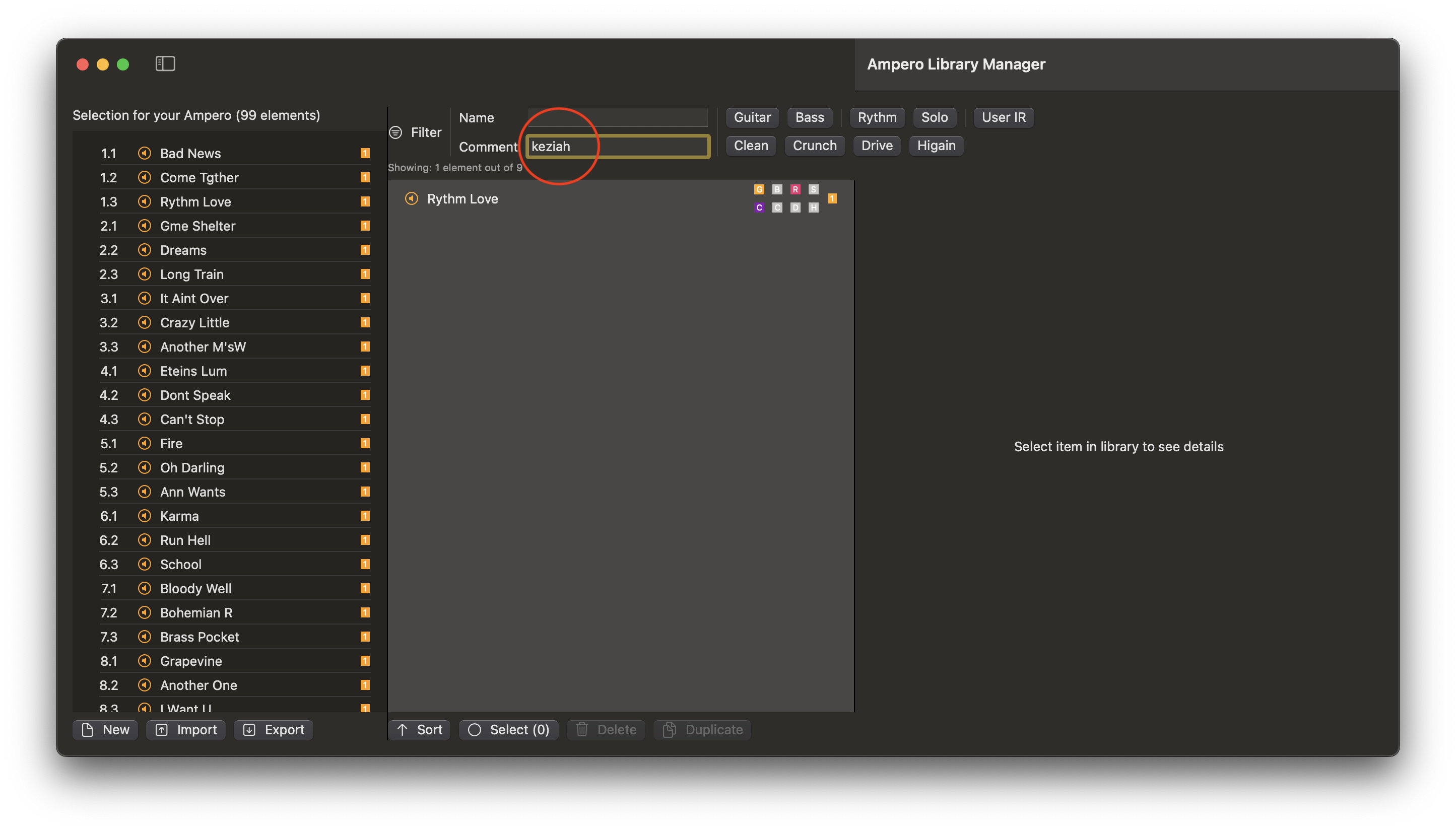
In this other example, only the patches with the “solo” description where displayed.
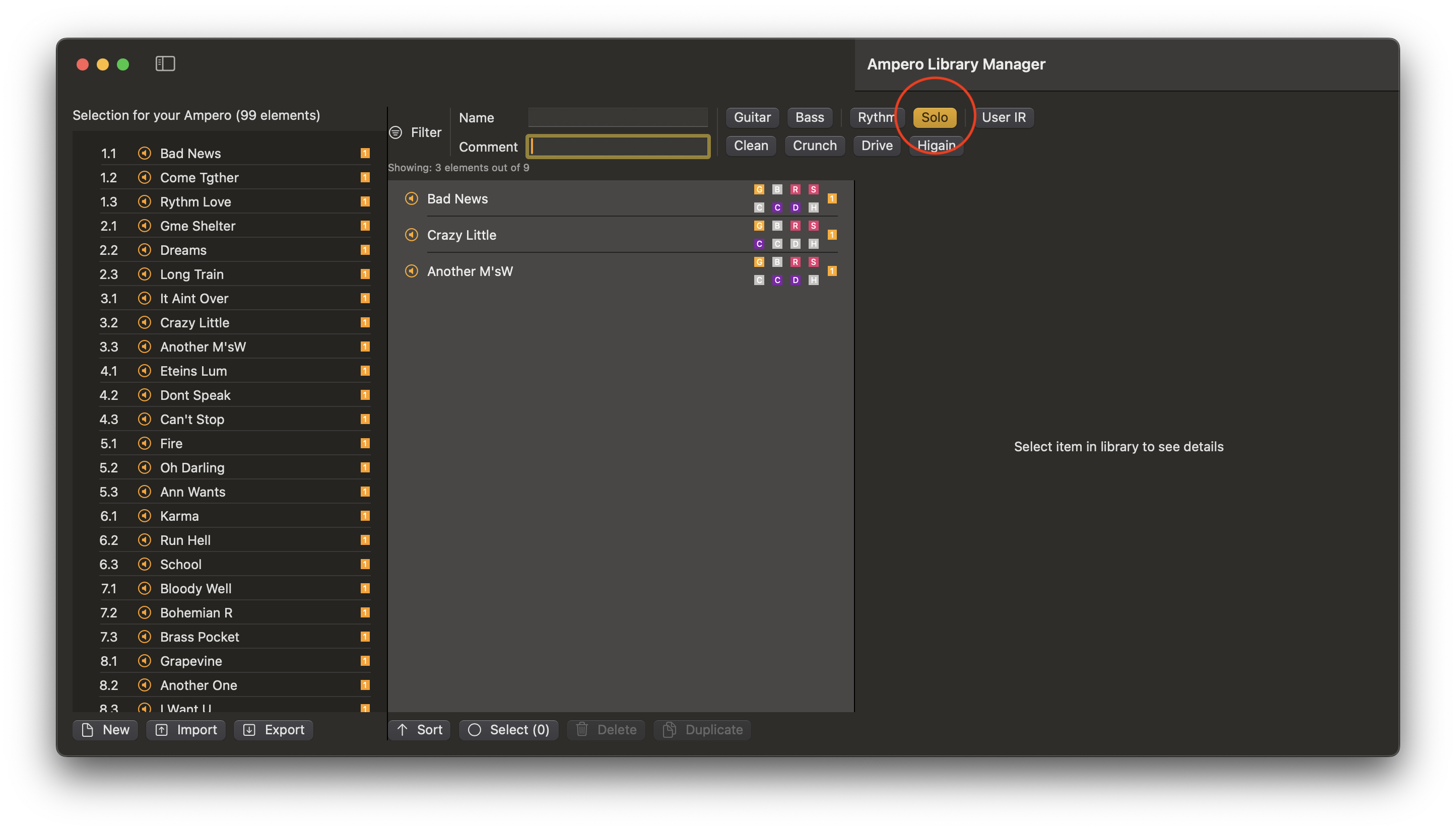
You can combine filters and text searches the way you want.
Modify an Ampero preset file or create a new one
At every moment, you can reorder or modify the content of your previously imported Ampero file, by simply drag and drop the patches from your library to the left panel.
And you can also start creating a new preset file that will be filled by 99 times the default patch, such as shown below.
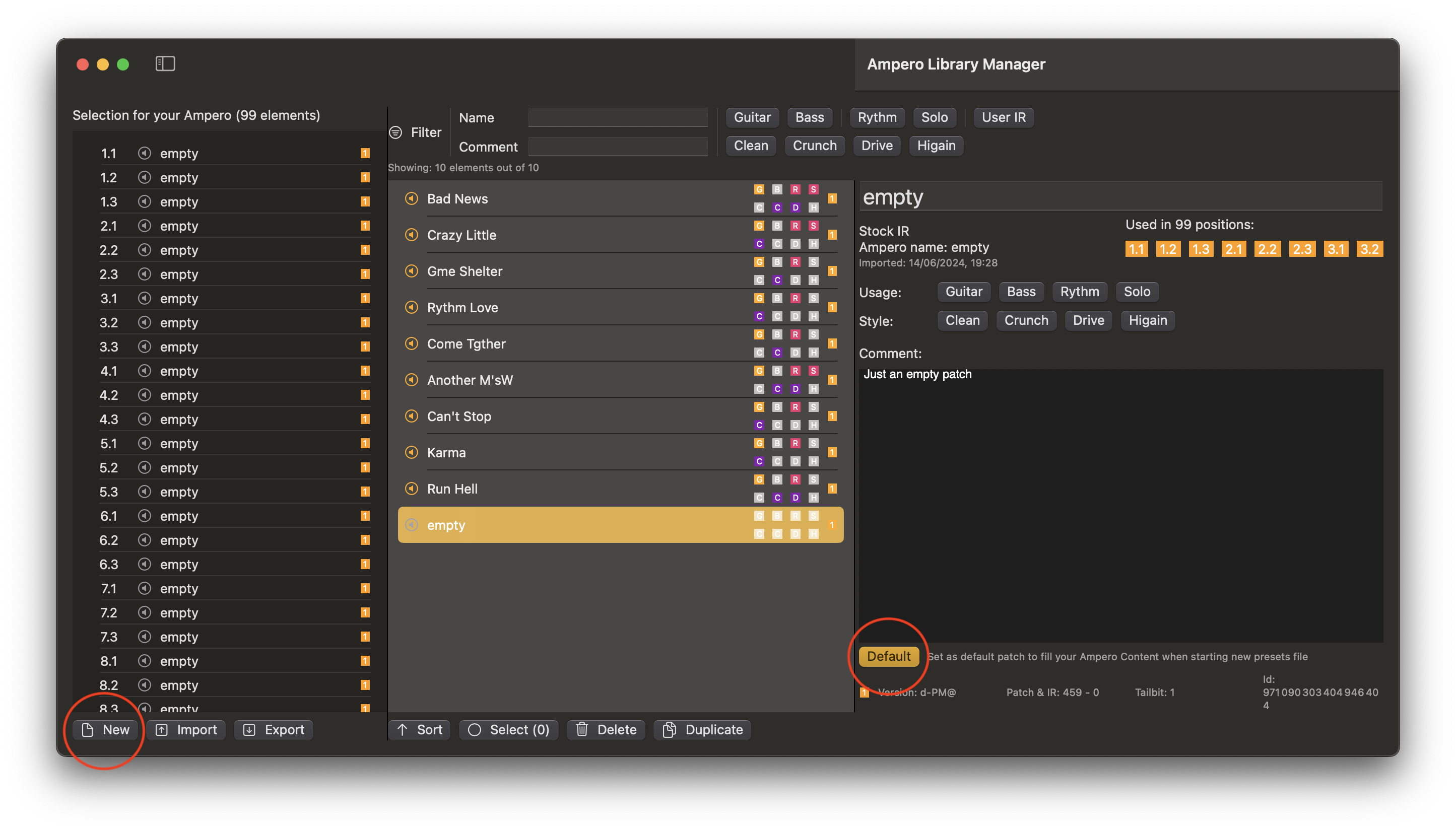
Then you can select one patch (or multiple patches with the Select button in the bottom of the library list), and drag and drop the selected patch(es) into the left panel. They will be inserted with the same order than in the library (order that you can manually modify, or sort alphabeticaly)
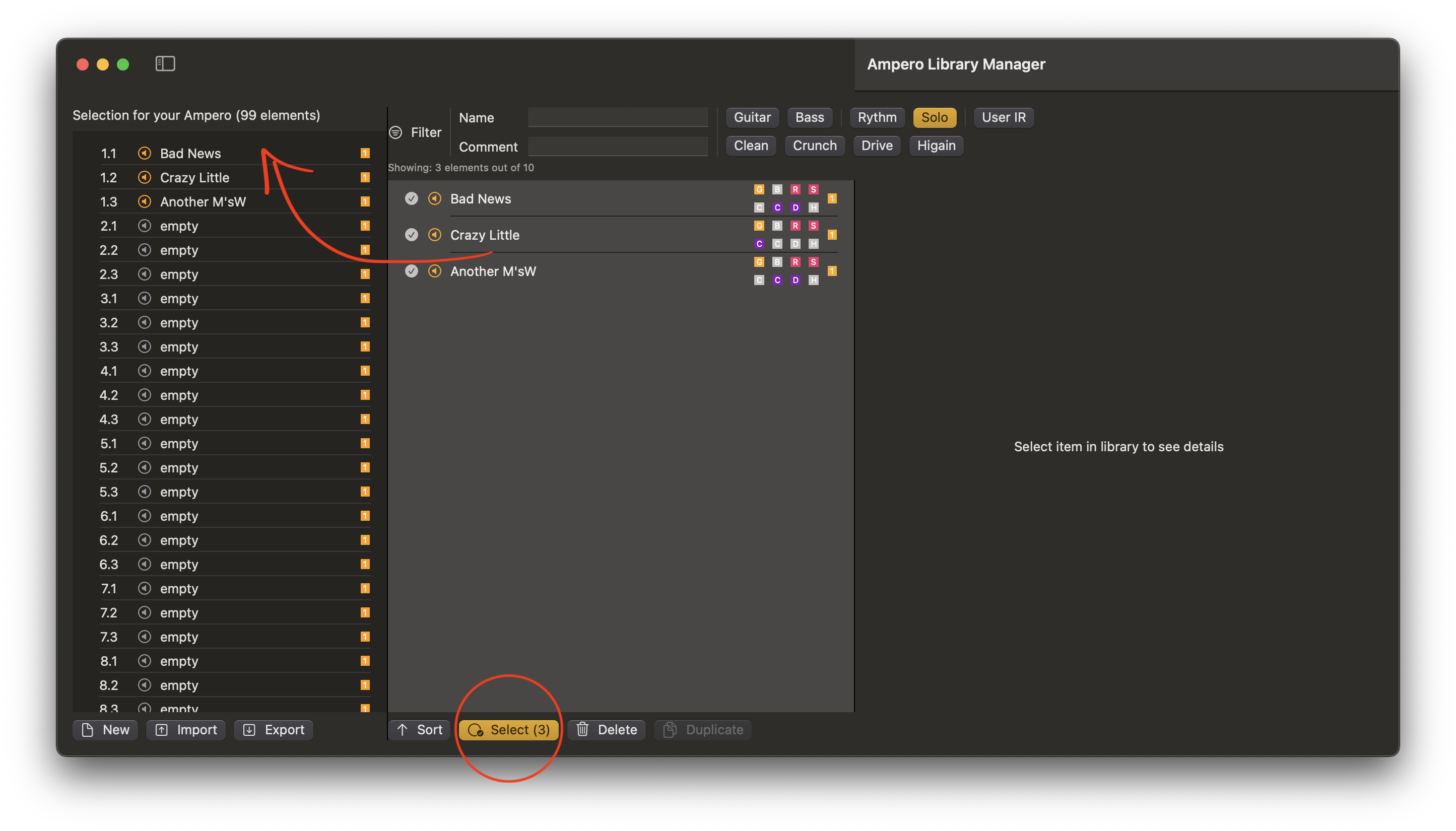
If you’re not satisfied with the order of the patches in the left panel, simply move the patches with the mouse. You can move one patch or a set of patches.
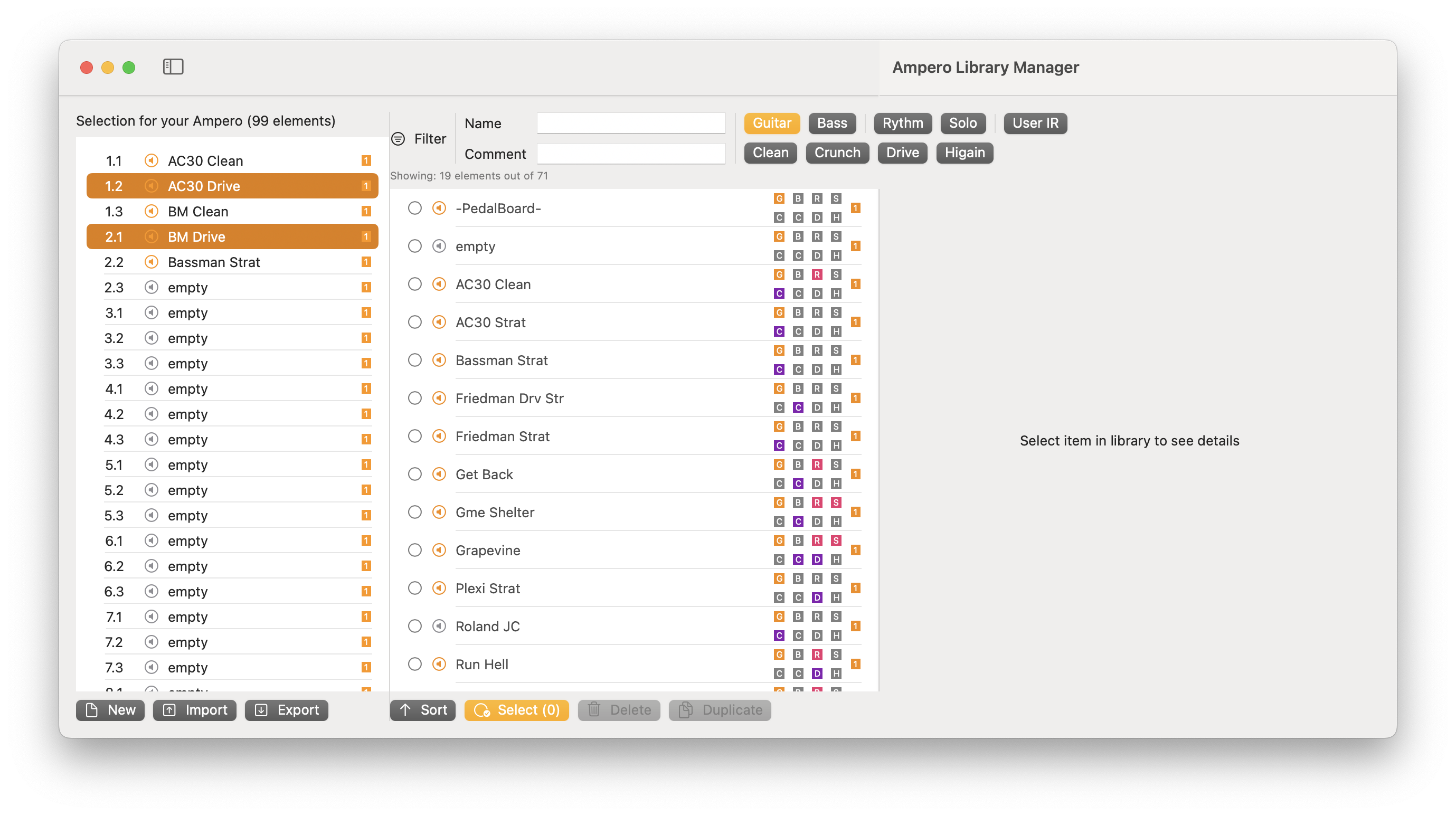
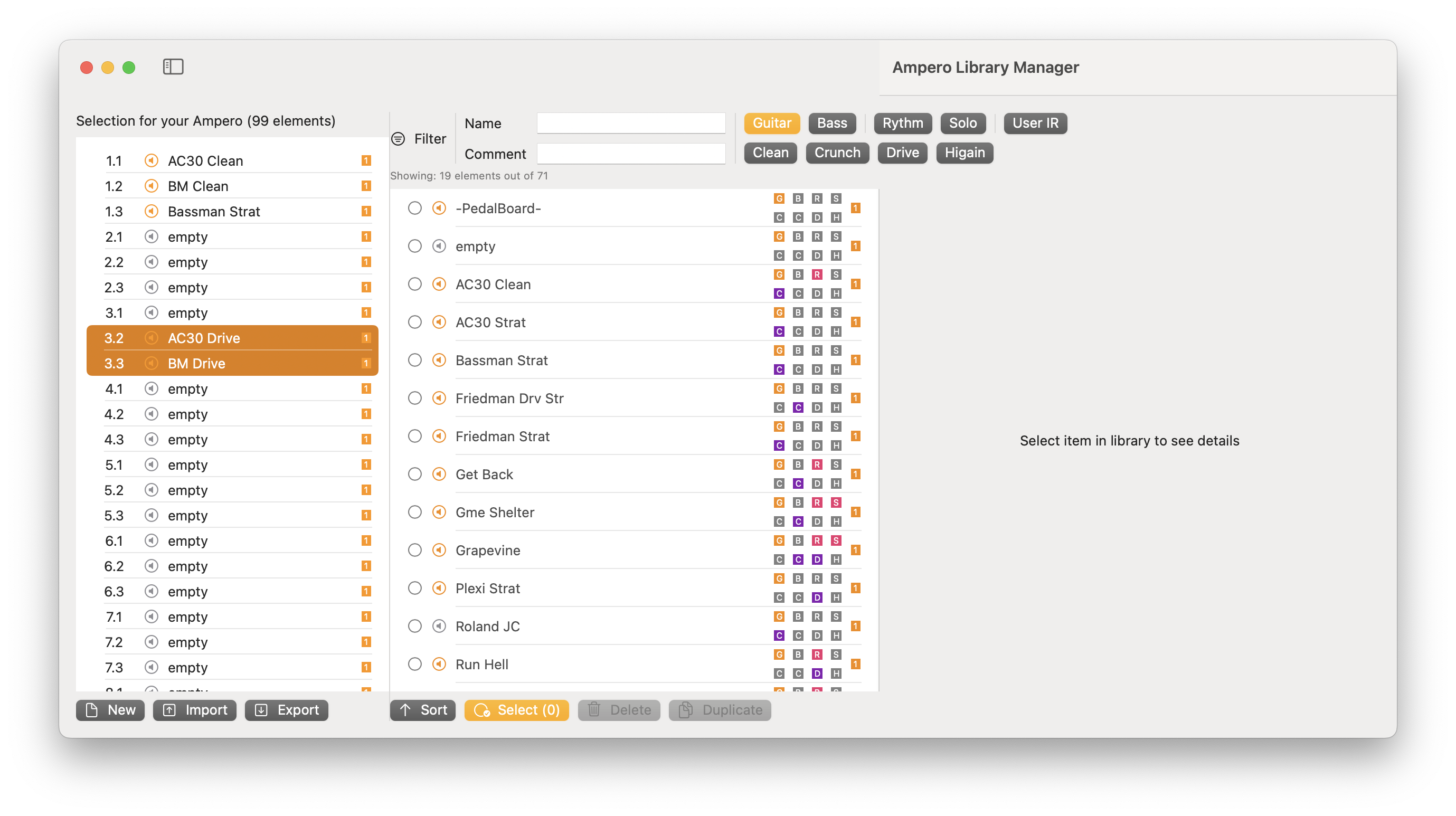
If you’re not satisfied with some patches you set, you can revert to your default patch one or more patches by clicking the “Reset” button.
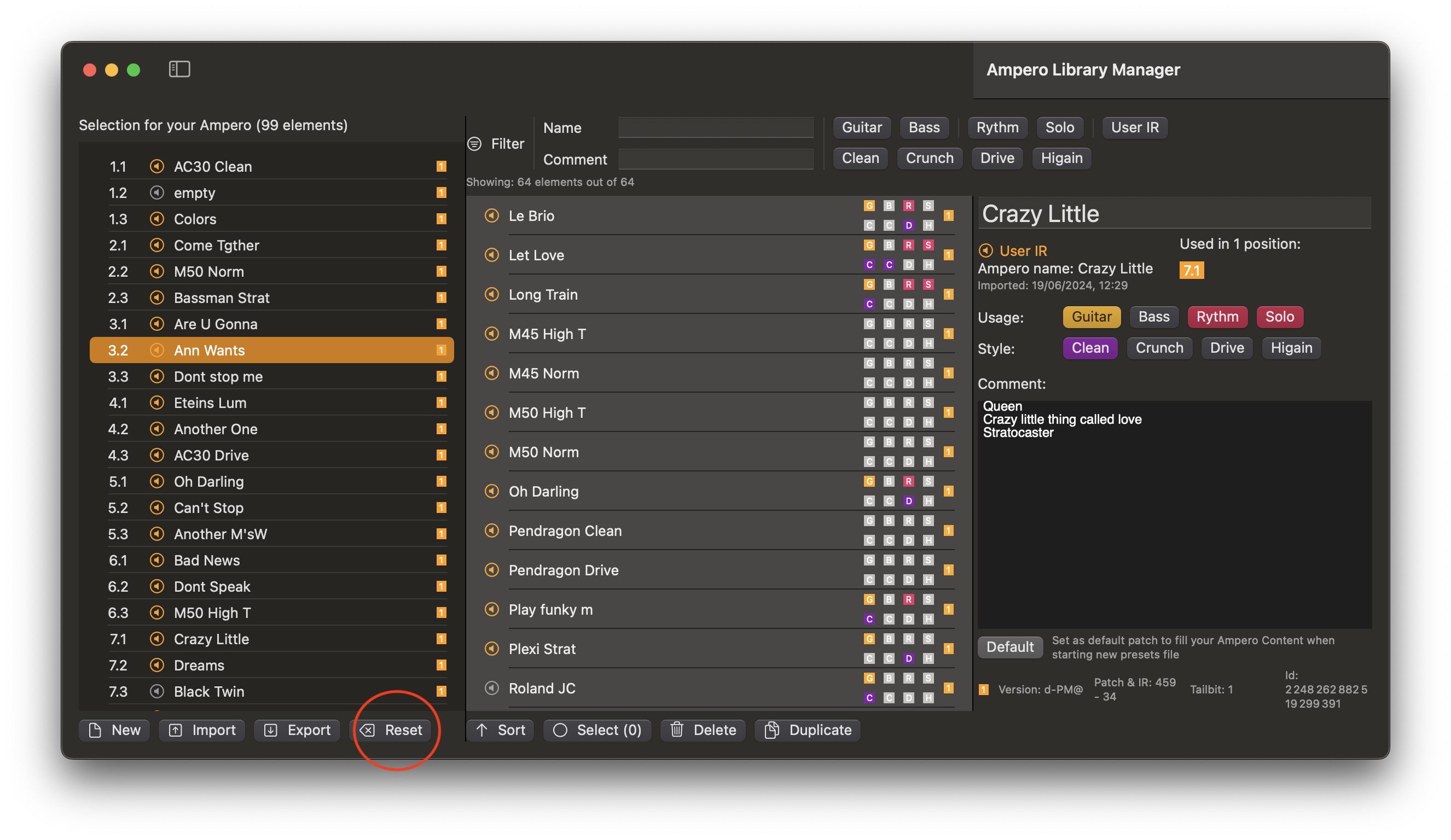
Export!
The last thing to do: export this newly created file and import it to your Ampero device, using the Hotone Ampero editor.
Enjoy!
Advanced information
There are a lot of features you should know about this application:
- Access the library folder: the library is a simple JSON file and standard Hotone format .prst files in a single directory. The names of the file are composed by the patch name and an identifier of the content of the file. You can easily find them in the library directory. To show the library directory, use the menu command (in the “Library” menu).
- Save a single patch from library: want to only export one patch from the library? Select it, and chose “Export one patch” from the library menu.
- Sort the library list: you can order the directory list the way you want by drag and droping the patches. You can also sort by alphabetical order (ascending or descending), using the “Sort” button or in the “View” menu.
- Multi-selection in library list: using the multi-selection button lets you select several patches using the check on the left of the name in the library panel, to drag and drop patches in the left panel, to merge 2 patches with same names (keeping the newest one) or to delete several patches.
- Disallow duplicates: when importing a patch in the library, if the patch already exists, it is not copied, it is selected in the library. Similarily if you select a lot of patches in the left panel and drag-drop them in the library but many of them are duplicates, they will not be copied.
- Duplicate: You can duplicate a patch in the library with the “Duplicate” button or in the “Library” menu. Thus you can have the same patch more than once in the library, with different names and/or different descriptions.
- Find duplicates: whatever the name, this function of the “Library” menu will select all duplicate patches in the list.
- Merge patches description: When you import a new version of a patch (with same name), both versions are kept in the library. The merge function can be used to keep the newest version only, with the descriptions (comment and toggles) of the oldest one. Use multi-selection to select the two patches to merge.
- Renaming propagation: when renaming a patch in the library, it is also renamed in the current list of the left panel.
- Multiple windows: the application lets you open multiple windows. All the windows share the same library, but handle a specific content in the left panel.
- Color scheme: you can chose between dark or light color scheme, or let the system chose for you (in the “View” menu).
- Inverted tailbit (beta): if you exported a file that your Ampero does not want to import, first try to check “Inverted tailbit” in the “File” menu, this could help. If not, let “Normal bit” and contact the developer to get some help.
- Avoid mixing various firmware versions: the little square on the right of the lists is a symbol showing the Ampero’s firmware version used when creating or updating the patch. I made a few tests about mixing versions and the Ampero doesn’t say anyhting and accept mixed versions in one file. But my advice would be… don’t mix versions (use only one color in an exported file).
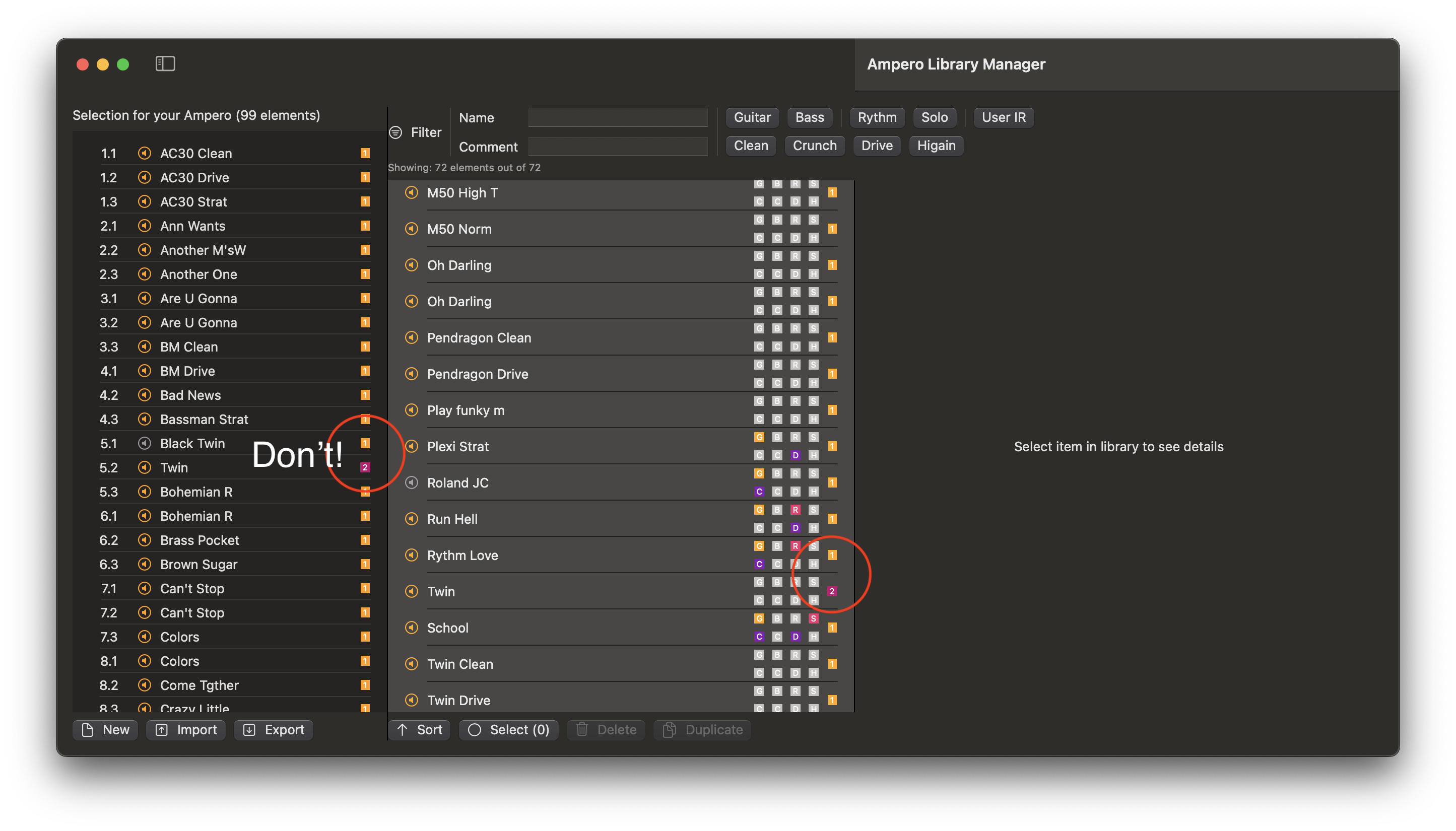
Warning
This software is not a Hotone Product, and has been created only by retro-engineering the Ampero preset files.
By using this software, you know that the generated .prst files have not been created by a genuine Hotone product and you assume taking the risk of using them.
If you disagree, don’t use the software.
Security
This application complies with Apple’s rules of application security:
- Sandboxed: it cannot access any ressources outside of the files you open and the files it saves.
- Signed with developer certificate: you know who’s the developer of this app (and yes, it’s me).
Need help or found a bug?
Contact the developer: mail to “contact (a) tducray.fr”
Support further development and bug fixes
Wanna help? Donate!
Why donate? I spend time at night to create and maintain this software… and I need to pay the Apple Development licence. How much do you evaluate this? From $1 to $10…
You can also buy the complete app source code for $1M. 
Privacy policy
Personal data
Ampero Library Manager does not collect any personal data, or any data for that matter. Everything you do with Ampero Library Manager stays on your computer. No data is transmitted by Ampero Library Manager to any system external to the computer, nor to any other application.
Stored data
Ampero Library Manager stores the patches (see description above) on your computer, as well as the descriptions you’ve entered via the library function. You can view or delete this data in the library folder (see above).
Accessed data
Ampero Library Manager only accesses the data it has stored, as described above.
Definitive deletion of data
Deleting the library folder on your computer permanently deletes all data.

